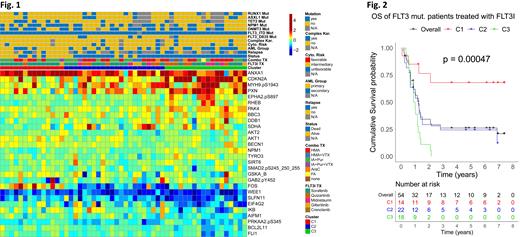CONCLUSION
FLT3 mutations are the most frequent genetic alteration in adult Acute Myeloid Leukemia (AML). The use of FLT3 inhibitors (FLT3I) has improved outcome among FLT3 mutant patients, but not all benefit. We developed a proteomic-based approach to stratify patients according to their response to FLT3I therapy.
The expression of 429 proteins (339 total, 90 post-translational modified) was measured by Reverse Phase Protein Arrays (RPPA) in fresh samples from 805 newly diagnosed AML patients, with levels normalized to normal CD34+ cells. Of 137 with FLT3 ITD or D835 mutations, 54 who were treated with FLT3I (Sorafenib=22, Quizartinib=11, Midostaurine=6, Gilteritinib=4 and Crenolanib=1) combined with other agents (Hypomethylating agents (HMA)=23, HMA+Venetoclax (VTX)=5, Idarrubicin+Cytarabine (AraC)+Purine Analogs (IA+Pur)=19, IA+Pur+VTX=2, AraC=3, Fludarabine+AraC (FA)=1, none=1) were selected for analyses. Proteins prognostic for Overall Survival (OS) and Complete Remission Duration (CRD) were identified using pairwise LogRank tests (p < 0.05) adjusted for False Discovery Rate, followed by unbiased hierarchical clustering. Continuous and categorial variables were compared with Wilcoxon, Kruskal-Wallis or Fisher's Exact test with simulated p-values (10000 replicates). Cox proportional hazards models (CoxPH) were developed for Uni-(UV) and Multi-variate (MV) analysis. Deep neural network analysis using random forest models identified proteins most predictive of cluster assignment.
28 proteins were individually prognostic for both OS and CRD and divided patients into 3 clusters (Fig. 1: C1=red, C2=blue, C3=green). The distribution of nearly all other clinical and molecular features did not differ between clusters, including: age, gender, race, cytogenetic risk and AML group. Co-occurrence with other mutations was not biased, except for FLT3+TET2 and FLT3+TET2+NPM1 mutants, more frequent in C1. OS was significantly longer (Fig. 2), in C1 (Median: C1>84mo, C2=14.8mo, C3=11.4mo; p<0.001) as was CRD (Median: C1>84mo, C2=8.6mo, C3=5.7mo; p<0.05). A similar OS pattern was observed for mutation combos, including with NPM1 or DNMT3a but not if IDH, CEBPa, TET2, or ASXL1 mutation were present. It was also seen when patients were divided by gender, age groups (except >70yo), primary, but not secondary AML, diploid karyotype and intermediary cytogenetic risk, and with Sorafenib or IA+PR therapies.
In the UV CoxPH model for OS, C1, C2 and C3 were predictive (HR=1, 4.1, 7.5; p=ref., 0.037, 0.009), along with age, secondary AML, complex karyotype, Trisomy 6 and IDH1 mutation. In the MV model for OS, only C1, C2 and C3 (HR=1, 3.3, 4.8; p=ref., 0.011, <0.001), and age were predictive. In the CRD UV model, C1 and C3 (HR=1, 3.3, 4.8; p=ref., 0.072, 0.022), age, secondary AML, and mutations in ASLX1, PTPN11, RAS, TP53 and WT1 were predictive. Only C1 and C3 were predictive in the MV model for CRD (HR=1, 2.9, 6.3; p=ref., 0.16, 0.04).
The predictive proteins, are biased towards specific cellular processes, mainly: proliferation and metabolism (RHEB, GSKA_B, SDHA, AKT1, AKT2 and TYRO3), cell cycle and DNA damage response (CDKN2A, DDB1, SIRT6, SLFN11 and WEE1), cellular adhesion and cytoskeleton organization (MYH9.pS1943, PAK4 and PXN), and apoptosis (AIFM1, BBC3 and BCL2L11). Key differences between clusters included: higher FOS in C1, and higher CDKN2A, MYH9.pS1943, PXN, PAK4, SDHA, BBC3 in both C2 and C3, with higher levels of these in C3. Since PAK4, PXN and MYH9 are connected to cellular motility/migration and inhibitors for those proteins are available, there is a therapeutic opportunity to overcome FLT3I resistance in C2/C3 patients. Moreover, we identified a set of 6 proteins (FOS, AKT1, PXN, SMARCA2, CDKN2A and DPF2) that predicted cluster assignment with 97.5% accuracy, making rapid patient stratification possible in the clinical setting.
Protein profiling identified cohorts of FLT3 mutant patients that achieved the highest benefit from FLT3I addition, regardless of all other clinical or molecular characteristics. We identified targetable proteins that are elevated in adverse signatures, and hypothesized that these may be targets for modulation to improve FLT3I response. Moreover, a small set of 6 proteins accurately classifies patients and could be used clinically to triage patients for treatment recommendation.
Disclosures
No relevant conflicts of interest to declare.


This feature is available to Subscribers Only
Sign In or Create an Account Close Modal